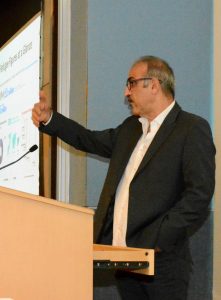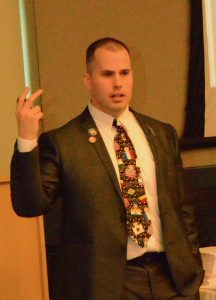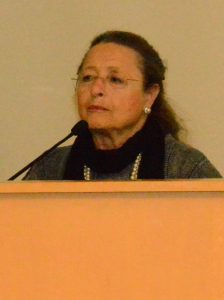- About Ramapo
- Academics
- Admissions & Aid
- Student Life
- Athletics
- Alumni
- Arts & Community
- Quick Links
- Apply
- Visit
- Give
GUMPERT TEACHERS’ WORKSHOP: THE RESETTLEMENT OF SURVIVORS OF GENOCIDE, CRIMES AGAINST HUMANITY AND MASS ATROCITY: PAST AND PRESENT
(PDF) (DOC) (JPG)February 1, 2017
(MAHWAH, NJ) – On November 18, 2015, The Gross Center for Holocaust and Genocide Studies in cooperation with and funding from the New Jersey State Commission on Holocaust Education sponsored a Gumpert Teachers’ Workshop, “The Resettlement of Survivors of Genocide, Crimes Against Humanity and Mass Atrocity: Past and Present.” Held at Ramapo College, it was attended by 75 educators from throughout New Jersey.
Dr. Michael A. Riff, Director of the Gross Center for Holocaust and Genocide, and Dr. Behzad Yaghmaian, Professor of Political Economy, each presented part of the keynote address. Dr. Riff’s segment concentrated on how today’s regime of refugee resettlement has its roots in the immediate aftermath of World War II. He pointed out that, then as now, immigration was a divisive political issue that pitted profound humanitarian concerns for the victims of war and oppression against the forces of naked bigotry, the fear of subversion and the interplay of special interests. Dr. Riff showed how events on the ground, from the influx of large numbers of refugees from Eastern Europe akin to today’s flight of Middle Eastern migrants to the foundation of the State of Israel and the Cold War, influenced policy in ways that were both predictable and unpredictable. Also as has been the case recently, he demonstrated how leadership from the Oval Office was both decisive and had its limits.
As Riff elaborated, the system put in place by the Displaced Persons Act and re-affirmed by continuing legislation in 1950 and bolstered by the U.N. Refugee Convention of 1951 cemented the public-private model for refugee resettlement into law that exists to this day. Just as today, immigration was a hot-button issue mired in xenophobia and outright bigotry. Adding fuel to the fire was the onset of the Cold War and the growth of anti-communism. Back then, the Red Scare that ensued tarred all Jewish survivors of the Holocaust with the brush of communism in a similar way that Islamophobia and the fear of terrorism are currently used to taint refugees from Syria and elsewhere in the Middle East.
 For his part, Professor Yaghmaian presented an overview of the migration issue, emphasizing its global and multi-faceted nature. While the main reason for migrants currently rushing to get into Europe is the turmoil in Syria and Iraq, economic dysfunction as well political implosion are dual motivators for people around the world fleeing their homes in search of the basics of life somewhere else.
For his part, Professor Yaghmaian presented an overview of the migration issue, emphasizing its global and multi-faceted nature. While the main reason for migrants currently rushing to get into Europe is the turmoil in Syria and Iraq, economic dysfunction as well political implosion are dual motivators for people around the world fleeing their homes in search of the basics of life somewhere else.
With that background in mind, Yaghmaian examined possible new international arrangements regarding migration. He sees hope in last month’s U.N. Summit “Addressing Refugees and Migrants” having produced the “New York Declaration” with the following proposals:
• Start negotiations leading to an international conference and the adoption of a global compact for safe, orderly and regular migration in 2018. The agreement to move toward this comprehensive framework is a momentous one. It means that migration, like other areas of international relations, will be guided by a set of common principles and approaches.
• Develop guidelines on the treatment of migrants in vulnerable situations. These guidelines will be particularly important for the increasing number of unaccompanied children on the move.
• Achieve a more equitable sharing of the burden and responsibility for hosting and supporting the world’s refugees by adopting a global compact on refugees in 2018.
 Gene Woods, an experienced and acclaimed Social Studies teacher from Bayonne High School, facilitated an exciting interactive session on how to bring the discourse about refugee resettlement into the classroom. As Woods stated at the outset, his hope is “to combine historical thinking with empathy and movement to action.” In modeling lesson plans, he pointed to the need to overcome the lack of knowledge among students about the refugee question, especially what motivates a person to leave his or her own country and seek safety or a better life elsewhere. Building compassion, for Woods, comes next. He suggested doing so with students by focusing on the writings of young Jews desperate to leave Nazi Germany in the 1930s and the obstacles they faced at the time, including Nazi-imposed at home and popular opposition to immigration in the United States. At the same time, he emphasized that students should understand that most of their forbears, as new immigrants from distant shores, were once in similar straits. Woods also drew attention to the program he helped initiate, “Food Not Bombs,” that welcomes resettled refugees in Bayonne and surrounding communities.
Gene Woods, an experienced and acclaimed Social Studies teacher from Bayonne High School, facilitated an exciting interactive session on how to bring the discourse about refugee resettlement into the classroom. As Woods stated at the outset, his hope is “to combine historical thinking with empathy and movement to action.” In modeling lesson plans, he pointed to the need to overcome the lack of knowledge among students about the refugee question, especially what motivates a person to leave his or her own country and seek safety or a better life elsewhere. Building compassion, for Woods, comes next. He suggested doing so with students by focusing on the writings of young Jews desperate to leave Nazi Germany in the 1930s and the obstacles they faced at the time, including Nazi-imposed at home and popular opposition to immigration in the United States. At the same time, he emphasized that students should understand that most of their forbears, as new immigrants from distant shores, were once in similar straits. Woods also drew attention to the program he helped initiate, “Food Not Bombs,” that welcomes resettled refugees in Bayonne and surrounding communities.
 Concluding the workshop was Ms. Judith Bihaly, a retired middle school math teacher from Fort Lee, New Jersey, who survived the Holocaust as a child in Budapest, Hungary. She provided a first-hand account of survival and the resettlement experience. As she explained, especially difficult were the final days of the Nazi occupation, when Hungarian fascists had a free hand to murder Jews they apprehended. Almost as harrowing, according to Ms. Bihaly, were the first weeks after the liberation of Budapest when, as a louse-ridden eleven-year-old in search of her parents, she found her apartment occupied by a former fascist family with close ties to the current Communist government. In some ways no less problematic was the reunion with her mother and twin brother, first in a DP Camp near Rome, then in Philadelphia, and finally in New York, where through perseverance and hard work she was able to realize her ambition of becoming an educator.
Concluding the workshop was Ms. Judith Bihaly, a retired middle school math teacher from Fort Lee, New Jersey, who survived the Holocaust as a child in Budapest, Hungary. She provided a first-hand account of survival and the resettlement experience. As she explained, especially difficult were the final days of the Nazi occupation, when Hungarian fascists had a free hand to murder Jews they apprehended. Almost as harrowing, according to Ms. Bihaly, were the first weeks after the liberation of Budapest when, as a louse-ridden eleven-year-old in search of her parents, she found her apartment occupied by a former fascist family with close ties to the current Communist government. In some ways no less problematic was the reunion with her mother and twin brother, first in a DP Camp near Rome, then in Philadelphia, and finally in New York, where through perseverance and hard work she was able to realize her ambition of becoming an educator.
E-News Archives
| 2023 | 2022 | 2021 | 2019 | 2018 | 2017 | 2016 | 2015 | 2014 | 2013 | 2012 | 2011 | 2010 | 2009 | 2008 | 2007 |Copyright ©2024 Ramapo College Of New Jersey. Statements And Policies. Contact Webmaster.

Follow Us!